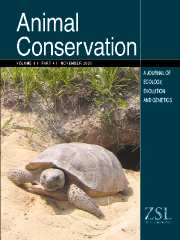Crossref Citations
This article has been cited by the following publications. This list is generated based on data provided by
Crossref.
Hingston, Melanie
Goodman, Steven M.
Ganzhorn, Jörg U.
and
Sommer, Simone
2005.
Reconstruction of the colonization of southern Madagascar by introducedRattus rattus.
Journal of Biogeography,
Vol. 32,
Issue. 9,
p.
1549.
Blench, Roger
2007.
New palaeozoogeographical evidence for the settlement of Madagascar.
Azania: Archaeological Research in Africa,
Vol. 42,
Issue. 1,
p.
69.
Dausmann, K. H.
Glos, J.
Linsenmair, K. E.
and
Ganzhorn, J. U.
2008.
Improved recruitment of a lemur-dispersed tree in Malagasy dry forests after the demise of vertebrates in forest fragments.
Oecologia,
Vol. 157,
Issue. 2,
p.
307.
Stokes, Vicki L.
Banks, Peter B.
Pech, Roger P.
and
Spratt, David M.
2009.
Competition in an invaded rodent community reveals black rats as a threat to native bush rats in littoral rainforest of south‐eastern Australia.
Journal of Applied Ecology,
Vol. 46,
Issue. 6,
p.
1239.
Harris, Donna B.
2009.
Review of negative effects of introduced rodents on small mammals on islands.
Biological Invasions,
Vol. 11,
Issue. 7,
p.
1611.
Irwin, Mitchell T.
Wright, Patricia C.
Birkinshaw, Christopher
Fisher, Brian L.
Gardner, Charlie J.
Glos, Julian
Goodman, Steven M.
Loiselle, Paul
Rabeson, Pascal
Raharison, Jean-Luc
Raherilalao, Marie Jeanne
Rakotondravony, Daniel
Raselimanana, Achille
Ratsimbazafy, Jonah
Sparks, John S.
Wilmé, Lucienne
and
Ganzhorn, Jörg U.
2010.
Patterns of species change in anthropogenically disturbed forests of Madagascar.
Biological Conservation,
Vol. 143,
Issue. 10,
p.
2351.
Tollenaere, Charlotte
Brouat, Carine
Duplantier, Jean‐Marc
Rahalison, Lila
Rahelinirina, Soanandrasana
Pascal, Michel
Moné, Hélène
Mouahid, Gabriel
Leirs, Herwig
and
Cosson, Jean‐François
2010.
Phylogeography of the introduced species Rattus rattus in the western Indian Ocean, with special emphasis on the colonization history of Madagascar.
Journal of Biogeography,
Vol. 37,
Issue. 3,
p.
398.
Clough, Yann
Abrahamczyk, Stefan
Adams, Marc-Oliver
Anshary, Alam
Ariyanti, Nunik
Betz, Lydia
Buchori, Damayanti
Cicuzza, Daniele
Darras, Kevin
Putra, Dadang Dwi
Fiala, Brigitte
Gradstein, S. Robbert
Kessler, Michael
Klein, Alexandra-Maria
Pitopang, Ramadhanil
Sahari, Bandung
Scherber, Christoph
Schulze, Christian H.
Shahabuddin
Sporn, Simone
Stenchly, Kathrin
Tjitrosoedirdjo, Sri S.
Wanger, Thomas C.
Weist, Maria
Wielgoss, Arno
and
Tscharntke, Teja
2010.
Tropical Rainforests and Agroforests under Global Change.
p.
15.
Russell, James C.
Ringler, David
Trombini, Aurélien
and
Le Corre, Matthieu
2011.
The island syndrome and population dynamics of introduced rats.
Oecologia,
Vol. 167,
Issue. 3,
p.
667.
Rickart, Eric A.
Balete, Danilo S.
Rowe, Rebecca J.
and
Heaney, Lawrence R.
2011.
Mammals of the northern Philippines: tolerance for habitat disturbance and resistance to invasive species in an endemic insular fauna.
Diversity and Distributions,
Vol. 17,
Issue. 3,
p.
530.
Knapp, Denise A.
2014.
Ecosystem Restoration on Santa Catalina Island: A Review of Potential Approaches and the Promise of Bottom-Up Invader Management.
Monographs of the Western North American Naturalist,
Vol. 7,
Issue. 1,
p.
421.
Murphy, Asia J.
Goodman, Steven M.
Farris, Zach J.
Karpanty, Sarah M.
Andrianjakarivelo, Vonjy
and
Kelly, Marcella J.
2016.
Landscape trends in small mammal occupancy in the Makira–Masoala protected areas, northeastern Madagascar.
Journal of Mammalogy,
p.
gyw168.
Dammhahn, Melanie
Randriamoria, Toky M.
and
Goodman, Steven M.
2017.
Broad and flexible stable isotope niches in invasive non-native Rattus spp. in anthropogenic and natural habitats of central eastern Madagascar.
BMC Ecology,
Vol. 17,
Issue. 1,
Steffens, Travis S.
Lehman, Shawn M.
and
Zimmermann, Elke
2018.
Lemur species-specific metapopulation responses to habitat loss and fragmentation.
PLOS ONE,
Vol. 13,
Issue. 5,
p.
e0195791.
Crowley, Brooke Erin
Castro, Ian
Soarimalala, Voahangy
and
Goodman, Steven M.
2018.
Isotopic evidence for niche partitioning and the influence of anthropogenic disturbance on endemic and introduced rodents in central Madagascar.
The Science of Nature,
Vol. 105,
Issue. 7-8,
Ehlers, Julian
Poppert, Sven
Ratovonamana, Rakotomalala Yedidya
Ganzhorn, Jörg Ulrich
Tappe, Dennis
and
Krüger, Andreas
2019.
Ectoparasites of endemic and domestic animals in southwest Madagascar.
Acta Tropica,
Vol. 196,
Issue. ,
p.
83.
Ehlers, Julian
Krüger, Andreas
Rakotondranary, Solofomalala Jacques
Ratovonamana, Rakotomalala Yedidya
Poppert, Sven
Ganzhorn, Jörg Ulrich
and
Tappe, Dennis
2020.
Molecular detection of Rickettsia spp., Borrelia spp., Bartonella spp. and Yersinia pestis in ectoparasites of endemic and domestic animals in southwest Madagascar.
Acta Tropica,
Vol. 205,
Issue. ,
p.
105339.
Kling, Katherine J.
Yaeger, Kimberley
and
Wright, Patricia C.
2020.
Trends in forest fragment research in Madagascar: Documented responses by lemurs and other taxa.
American Journal of Primatology,
Vol. 82,
Issue. 4,
Andriatsitohaina, Bertrand
Ramsay, Malcolm S.
Kiene, Frederik
Lehman, Shawn M.
Rasoloharijaona, Solofonirina
Rakotondravony, Romule
and
Radespiel, Ute
2020.
Ecological fragmentation effects in mouse lemurs and small mammals in northwestern Madagascar.
American Journal of Primatology,
Vol. 82,
Issue. 4,
Fiedler, Paula M. A.
De Lapparent, Alice
Razafitsalama, Jeremie
Sanamo, Justin
Steffens, Kim J. E.
and
Ganzhorn, Jörg U.
2021.
Secondary seed removal in a degraded forest habitat in Madagascar.
Scientific Reports,
Vol. 11,
Issue. 1,


